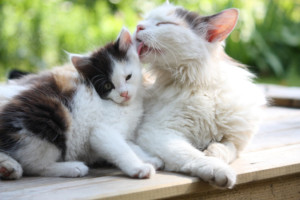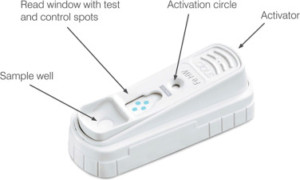Earlier this month, we published a post on FeLV… so now it’s only right that we tackle FIV as well!
Just the other day, a friend told me that they were interested in adopting a cat, and came across the term “FIV” in their search. They told me that they didn’t want to adopt a “sick” cat, because they were concerned about medical bills and wanted a cat that would live a long life. Naturally, this conversation made me think that a lot of people probably aren’t too familiar with FIV, and maybe a wittily penned blog post could help educate them…
First things first: what exactly is FIV, and how do cats get it?
FIV stands for Feline Immunodeficiency Virus. Most commonly, FIV is transmitted via a deep bite wound from an infected cat to a non-infected cat. Less commonly, it can be transmitted via blood-blood contact, in utero, and from the milk of an infected mother cat. It is extremely rare for FIV to be transmitted through the sharing of food and water bowls, or general space with an infected cat. In fact, many FIV + cats live amongst FIV – cats without ever infecting them. Because outdoor cats have a higher likelihood of receiving a deep bite wound from another cat, they are at a higher risk of contracting FIV. Therefore, it is important to keep this in mind when considering whether or not to let your kitty outside! FIV is NOT transmittable to dogs, people, or other small mammals.
What does it mean if a cat has FIV?
Well, generally FIV means that the infected cat has a weakened immune system. They can be more susceptible to general viruses or Upper Respiratory Infections, but with a healthy diet and proper vet care, FIV cats live long, healthy lives.
There generally aren’t many obvious signs that a cat has FIV, so to know for sure, cats are tested via a SNAP test. Essentially, a SNAP test is a blood draw that tests the possible affected cat’s blood to look for antibodies to FIV. A cat can test positive as early as two to four weeks after exposure, but it may take up to eight weeks, so it’s always a good idea to do a follow-up test a few weeks after the initial. Kittens under six months of age often test falsely positive due to the existence of antibodies received from their mothers either in utero or via milk. Therefore, retesting kittens after they reach six months of age is always recommended. Many shelters don’t even test kittens under 6 months old to avoid an initial false positive test.
Is FIV treatable?
As of right now, there is no cure for FIV. However, the key to managing this disease is consistent vet checks to be sure that any secondary diseases are appropriately treated. For example, FIV + cats often are more prone to dental disease, so it is important to have their teeth checked at least once a year (if not more often) by a vet. Additionally, a healthy diet can do wonders for a cat with a weakened immune system!
So there ya have it! FIV is certainly not as scary as it sounds. While these special kitties need a little bit of extra TLC, they can be happy, healthy cats with the proper care. Sadly, FIV + cats often have quite a long length of stay in shelters because people are afraid to take a chance on a “sick” cat. If you’re in the market for a new furry friend, please consider scooping up one of these sweeties… you won’t regret it!





